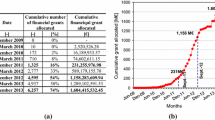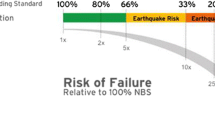Abstract
The 2010–2011 Canterbury earthquakes, which involved widespread damage during the February 2011 event and ongoing aftershocks near the Christchurch Central Business District, left this community with more than $NZD 40 billion in losses (~20 % GDP), demolition of approximately 60 % of multi-storey concrete buildings (3 storeys and up), and closure of the core business district for over 2 years. The aftermath of the earthquake sequence has revealed unique issues and complexities for the owners of commercial and multi-storey residential buildings in relation to unexpected technical, legal, and financial challenges when making decisions regarding the future of their buildings impacted by the earthquakes. The paper presents a framework to understand the factors influencing post-earthquake decisions (repair or demolish) on multi-storey concrete buildings in Christchurch. The study, conducted in 2014, includes in-depth investigations on 15 case-study buildings using 27 semi-structured interviews with various property owners, property managers, insurers, engineers, and government authorities in New Zealand. The interviews revealed insights regarding the multitude of factors influencing post-earthquake decisions and losses. As expected, the level of damage and repairability (cost to repair) generally dictated the course of action. There is strong evidence, however, that other variables have significantly influenced the decision on a number of buildings, such as insurance, business strategies, perception of risks, building regulations (and compliance costs), and government decisions. The decision-making process for each building is complex and unique, not solely driven by structural damage. Furthermore, the findings have put the spotlight on insurance policy wordings and the paradoxical effect of insurance on the recovery of Christchurch, leading to other challenges and issues going forward.





Similar content being viewed by others
References
Applied Technology Council (ATC) (1995) Addendum to the ATC-20 post earthquake building safety evaluation procedures. Redwood City, California
Axco (2014) Insurance market report—New Zealand
Bradley BA, Quigley MC, Van Dissen RJ, Litchfield NJ (2014) Ground motion and seismic source aspects of the Canterbury earthquake sequence. Earthq Spectra 30(1):1–15
Brown C, Seville E, Vargo J (2013) The role of insurance in organizational recovery following the 2010 and 2011 Canterbury earthquakes. Resilient Organisations Research Report 2013/4
Building Act (2004) New Zealand Government, 24 August 2004
Canterbury District Health Board (CDHB) (2012) Built infrastructure policy and decision-making framework. Version 2. Jan 2012
Canterbury Earthquakes Royal Commission (2011) Volume 2: The performance of Christchurch CBD buildings. http://canterbury.royalcommission.govt.nz/Final-Report-Volume-Two-Contents. Accessed Feb 2015
Chang SE, Taylor JE, Elwood KJ, Seville E, Brunsdon D, Gartner M (2014) Urban disaster recovery in Christchurch: the central business district cordon and other critical decisions. Earthq Spectra 30(1):513–532
Christchurch Central Development Unit (CCDU) (2012) The recovery plan. http://ccdu.govt.nz/the-plan. Accessed Jan 2015
Christchurch City Council (CCC) (2010) Christchurch City Council earthquake-prone, dangerous and insanitary buildings policy, 2010. Christchurch City Council, 10 Sept 2010
Department of Building and Housing (DBH) (2011) Compliance document for New Zealand Building code. Clause B1. Structure. Amendment 10 (Canterbury)
Drayton MJ, Verdon CL (2013) Consequences of the Canterbury earthquake sequence for insurance loss modelling. In: Proceedings of the 2013 New Zealand Society for Earthquake Engineering Technical Conference, paper 44, 26–28 April 2013
Earthquake Commission (EQC) (2012) Cover: an insurers guide. http://www.eqc.govt.nz/what-we-do/eqc-insurance/insurers-guide. Accessed March 2015
Egbelakin TK, Wilkinson S, Potangaroa R, Ingham J (2011) Enhancing seismic risk mitigation decisions: a motivational approach. Constr Manage Econ 29(10):1003–1016
Engineering Advisory Group (EAG) (2012) Guidance on detailed engineering evaluation of earthquake affected non-residential buildings in Canterbury. Part 2—evaluation procedure. Revision 7, 2012, Structural Engineering Society New Zealand (SESOC), Christchurch
Ernst, Young (2012) CERA Christchurch Central City—commercial property market study. Released by the minister for Canterbury earthquake recovery, May 2012
Federal Emergency Management Agency (FEMA) 308 (1998) Repair of earthquake damaged concrete and masonry wall buildings. Federal Emergency Management Agency, Washington DC
Galloway BD, Hare HJ (2012) A review of post-earthquake building control policies with respect to the recovery of the Christchurch CBD. In: Proceedings of the 2012 New Zealand Society for Earthquake Engineering Technical Conference, paper 036, 13–15 April 2012
Jacques CC, McIntosh J, Giovinazzi S, Kirsch TD, Wilson T, Mitrani-Reiser J (2014) Resilience of the Canterbury hospital system to the 2011 Christchurch earthquake. Earthq Spectra 30(1):533–554
Kam WY, Pampanin S (2011) General performance of buildings in Christchurch CDB after the 22 Feb 2011 earthquake: a contextual report, (prepared for the Department of Building and Housing) Department of Civil and Natural Resources Engineering, University of Canterbury
Kim J (2015) Quantitative analysis of factors influencing post-earthquake decisions on concrete buildings in Christchurch. Master’s Thesis, University of British Columbia, Vancouver, Canada. (In Preparation)
King A, Middleton D, Brown C, Johnston D, Johal S (2014) Insurance: its role in recovery from the 2010–2011 Canterbury earthquake sequence. Earthq Spectra 30(1):475–491
Marquis F (2015) A framework for understanding post-earthquake decisions on multi-storey concrete buildings in Christchurch, New Zealand. Master’s Thesis, University of British Columbia, Vancouver, Canada. (In Preparation)
Middleton D (2012) Insurance shocks: market behaviour and government responses: international case studies with relevance to New Zealand, Kestrel Group, June 2012
Miles S, Brechwald D, Davidson R, Demeter K, Johnston D, Pampanin S, Wilkinson S (2014) Building back better. Case study of the 2010–2011 Canterbury, New Zealand earthquake sequence. EERI report with the NZSEE and the natural hazards platform for the global facility for disaster reduction and recovery of the World Bank. Oakland CA: EERI, February
Muir-Wood R (2012) The Christchurch earthquakes of 2010 and 2011. The Geneva risk reports. Risk and insurance research. Extreme events and insurance: 2011 Annus horribilis. Courbage C, Stahel WR Geneva. http://www.genevaassociation.org. Accessed Jan 2015
New Zealand Society for Earthquake Engineering (NZSEE) (2009) Building safety evaluation during a state of emergency: guidelines for territorial authorities. New Zealand Society for Earthquake Engineering, August 2009
New Zealand Supreme Court (NZSC) (2013) Ridgecrest NZ Limited V IAG New Zealand Limited [27 August 2014] NZSC 117
New Zealand Supreme Court (NZSC) (2014) University of Canterbury v Insurance Council of New Zealand [22 Dec 2014] NZSC 193
Pampanin S, Kam WY, Akguzel U, Tasligedik S, Quintana-Gallo P (2012). Seismic performance of reinforced concrete buildings in the Christchurch CBD under the 22nd February earthquake. Report prepared for Christchurch City Council and University of Canterbury, Civil and Natural Resources Engineering
Petak WJ, Alesch DJ (2004) Organizational decision making with respect to extreme events: healthcare organizations respond to California’s SB 1953. In research progress and accomplishments: 2003–2004 (MCEER-04-P01). University of Buffalo, State University of New York, Buffalo
Polese M, Di Ludovico M, Marcolini M, Prota A, Manfredi G (2014) Assessing reparability: simple tools for estimation of costs and performance loss of earthquake damaged reinforced concrete buildings. Earthq Eng Struct Dyn. doi:10.1002/eqe.2534
Property Council of New Zealand (PCNZ) (2014) Submission on the building (earthquake-prone buildings) amendment Bill. http://www.propertynz.co.nz/index.php/news. Accessed Jan 2015
RLB (2014) International report—construction market intelligence. Third Quarter
SwissRe (2012) Lessons from recent major earthquakes. Economic research and consulting. Jan 2012
Uma SR, Nayyerloo M, Dhakal RP (2013) Vulnerability assessment of Christchurch buildings in Canterbury earthquakes. GNS Science Report 2013/20. May 2013, p 35
Vero (2007) Business plan policy. Version 6. Policy wording. https://www.vero.co.nz/business-insurance. Accessed Jan 2015
Vero (2013) Business plan policy endorsement, July 2013. Policy wording. https://www.vero.co.nz/business-insurance. Accessed Jan 2015
Yang TY, Moehle J, Stojadinovic B, Der Kiureghian A (2009) Performance evaluation of structural systems: theory and implementation. ASCE J Struct Eng 135(10):1146–1154
Zurich (2009) Material damage and business interruption insurance. Policy wording. http://www.zurich.co.nz/content/zurich_nz/insurance/property-insurance/material-damage-business-interruption-insurance.html. Accessed Jan 2015
Acknowledgments
This research was conducted in collaboration with CERA, the Christchurch City Council, GNS Science, the Ministry of Business, Innovation, and Employment (MBIE), and the University of Auckland. The authors gratefully acknowledge the contribution of Erica Seville and Dave Brunsdon from Resilient Organisations in discussing the research design and context, developing an appropriate list of interviewees, and providing logistical assistance. We also acknowledge the generous cooperation and time provided by the interviewees and local engineers throughout this study. Support for the University of British Columbia research team was provided by the Natural Sciences and Engineering Research Council of Canada.
Compliance with ethical standard
The primary research for this paper received ethics approval from the University of British Columbia Behavioural Ethics Research Board (ID: H14-01332) as well as the University of Auckland Human Participants Ethics Committee (ID: 012911).
Author information
Authors and Affiliations
Corresponding author
Appendix 1
Appendix 1
List of interviewees by category | Interview location and date |
|---|---|
Category A: Building executive officers/owner’s representatives | |
Connal Townsend, Chief Executive: Property Council of New Zealand | Auckland, 14 October 2014 |
Darren Moses, Unit Manager: Christchurch City Council | Christchurch, 29 October 2014 |
David Meates, Chief Executive: Canterbury District Health Board | Christchurch, 24 September 2014 |
Gary Jarvis, Group Operations Manager: Heritage Hotel Management | Auckland, 13 October 2014 |
Jeff Field, University Registrar: University of Canterbury | Christchurch, 26 September 2014 |
Josie Ogden-Schroeder, Chief Executive: YMCA Christchurch | Christchurch, 25 September 2014 |
Mark Youthed, Senior Commercial Asset Manager: Knight Frank | Christchurch, 24 September 2014 |
Miles Romanes, Project Manager: Pace Project Management | Christchurch, 24 September 2014 |
Participant A1, Structural Engineer | Christchurch, 23 September 2014 |
Category B: Building developers/property investors | |
Chris Gudgeon, Chief Executive: Kiwi Income Property Trust | Auckland, 15 October 2014 |
Ernest Duval, Trust Manager/CEO: ETP/Fortis Construction | Christchurch, 24 September 2014 |
Glen Boultwood, Fund Manager: Eureka Funds | Auckland, 15 October 2014 |
Lisle Hood, Property Investor: Business Building Systems | Christchurch, 22 October 2014 |
Miles Middleton, Property Investor: Viewmount Orchards | Christchurch, 25 September 2014 |
Participant B1, General Manager | Christchurch, 5 November 2014 |
Peter Rae, Chairman and Managing Director: Peter Rae Industries | Christchurch, 23 September 2014 |
Philip Burdon, Property Investor and Developer | Christchurch, 5 November 2014 |
Shaun Stockman, Managing Director: KPI Rothschild Property | Christchurch, 22 September 2014 |
Category C: Insurance | |
Jimmy Higgins, Executive GM—Earthquake Programme: Vero NZ | Auckland, 15 October 2014 |
John Lucas, Insurance Manager: Insurance Council of New Zealand | Wellington, 17 October 2014 |
Murray Spicer, Engineer acting for insurers: MacDonald Barnett | Auckland, 14 October 2014 |
Simon Foley, Distribution Manager: Zurich New Zealand | Auckland, 15 October 2014 |
Storm McVay, Executive Broker: Crombie Lockwood | Christchurch, 22 September 2014 |
Category D: Government authorities | |
John O’Hagan, Lead Engineer—Significant Buildings Unit: CERA | Christchurch, 22 October 2014 |
John Snook, Structural Engineer: CERA | Christchurch, 30 September 2014 |
Participant D1, CERA | Christchurch, 26 September 2014 |
Steve McCarthy, Regulatory Services Manager: CCC | Christchurch, 26 September 2014 |
Rights and permissions
About this article
Cite this article
Marquis, F., Kim, J.J., Elwood, K.J. et al. Understanding post-earthquake decisions on multi-storey concrete buildings in Christchurch, New Zealand. Bull Earthquake Eng 15, 731–758 (2017). https://doi.org/10.1007/s10518-015-9772-8
Received:
Accepted:
Published:
Issue Date:
DOI: https://doi.org/10.1007/s10518-015-9772-8




